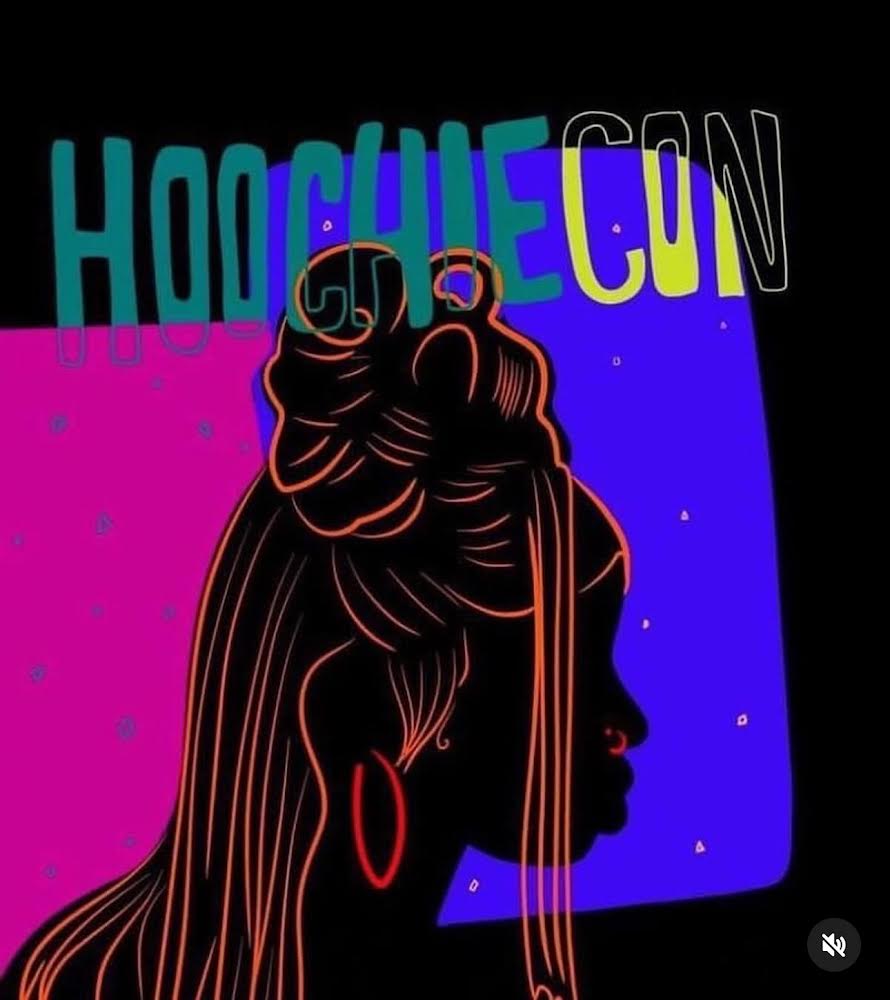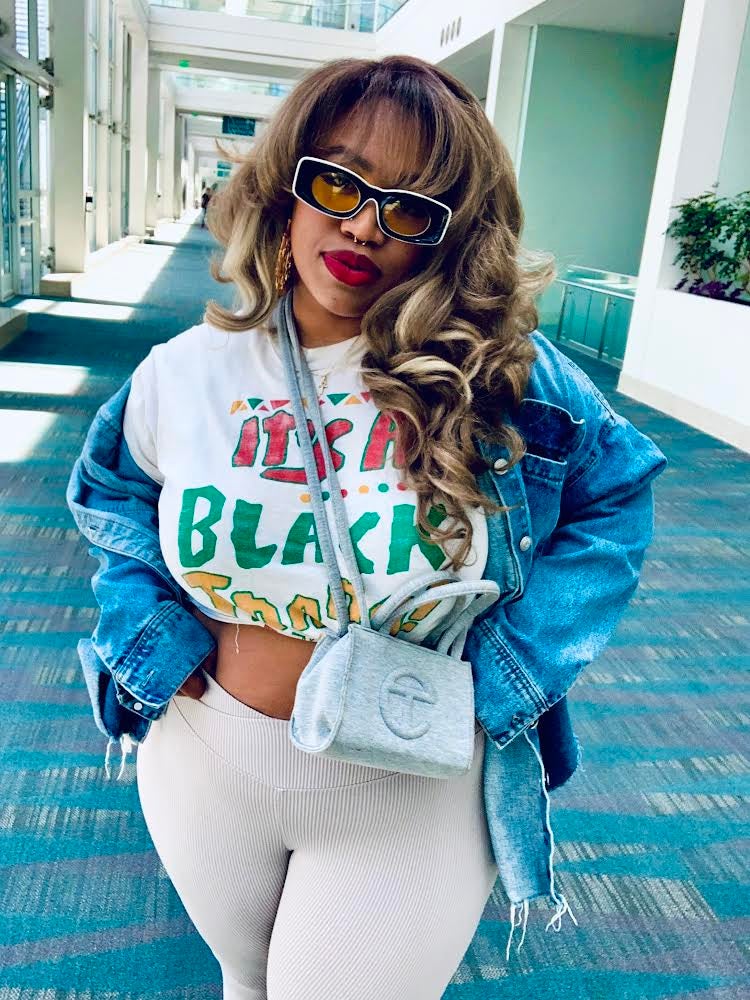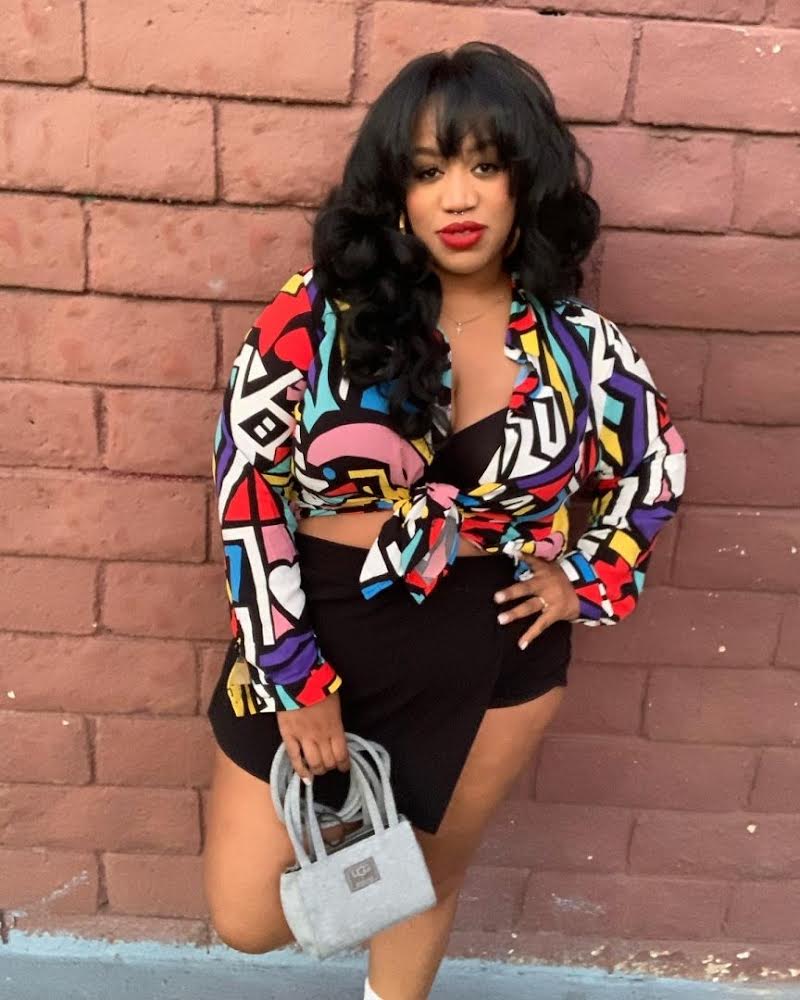
When a Black woman gives herself the gift of self-acceptance; prioritizing what feels good over external validation— the results can be glorious. Just ask Zorine Truly, the Hoochie Historian, digital archivist, and creator of the annual HoochieCon festival.
The Los Angeles-based, Memphis-raised creative is building community around hoochie culture. It’s a rebuke of the many ways people attempt to squash and flatten Black womanhood into a box. Despite popular misconceptions, there isn’t a cookie-cutter look of a Hoochie, explains Truly. She says that, ultimately, it’s about the relationship to self.
“The same person that’s covered from head to toe can be a Hoochie because she stands in what she likes to wear and her beauty,” Truly tells ESSENCE. “Maybe she’s a Hoochie because she wants to wear gold from top to bottom,” she continues, emphasizing the importance of giving humanity to the movement. “It’s not a costume.”
The community Truly has curated—which has amassed over 20 million views across social media— includes her Hoochie History video series, the forthcoming Hoochie Trivia night, a HoochieCon festival, and a Hoochie group chat on Discord. The goal is to celebrate, and create space for, the different facets of who we are through beauty, style, and exercising our agency.
In Truly’s world, beauty is a treasure trove of possibilities. It’s a vehicle for self-expression and exploration, a divine return to self, and a special form of meditation.
“I’ll sit down in my bathroom with my lil’ mirrors and stuff. I will go through and look at things that inspire me,” she says. As for where the Hoochie Historian finds inspiration these days? “Not to toot my own horn but I’m going to the HoochieCon page,” laughs Truly. “I get deep in the archives, babe.” Specifically, she’s looking at people like the late Angel Bennette Wilson, whose nostalgic images from the ‘90s. “She is very influential to me because of her style.”
Additionally, “I might put on Three 6 Mafia or I might put on Adina Howard. I just sit there and do my makeup and relax,” she says, releasing a deep exhale. “You know as kids when we’d play dress up or put on our mom’s clothes? I like to do that now. I’m not going anywhere but I like to play.”
Like a true beauty enthusiast, Truly adds her signature touch during any glam process. “I’m always and forever loving a heavy brown liner,” she says. “I also use blush as the pink in my lip color and then top that with clear gloss. So amazing!” Much like her approach to playing dress up, “I just like to play around with colors for lip combinations.”
Here, Truly opens up about how Hoochie culture is a form of punk culture, letting her Memphis roots shine inspire her beauty choices, and how elder Hoochies helped Truly tap into her “it girl” energy.

ESSENCE: What was your relationship to beauty like in your earlier years?
Zorine Truly: I think my experience is one that a lot of Black girls, especially plus-size Black girls, can relate to. There was representation on television in the 90s and a lot of times I saw myself in those people because they were Black, but I didn’t really see myself style-wise and physicality-wise. So as a kid I kind of had issues with feeling like I met the beauty standard for Black women.
I was raised Catholic, which is like trying to be as modest as you can be, but I was still in and influenced by my neighborhood. My mom gave me room to dress and express myself how I wanted. As I got into my teen hood, I went completely opposite of that and gravitated towards what she would call my hoochie uniform. (Laughs)
What was your experience with beauty standards, being raised in a Catholic environment?
Truly: When I came up it was very much about assimilation and how close to whiteness you could be. It wasn’t necessarily about celebrating things we popularized — like hairstyles. I was raised in North Memphis, which is the hood, and my mom was doing everything she could to get me to move further away from that. She wanted me to embrace the places that she was placing me in. It never felt authentic but it was a requirement in order to be accepted.
It’s wild looking back at that time. It’s like, oh, I don’t think I was wearing Hollister every day and frying my hair straight simply because I liked it. The assimilation was so real.
TRULY: (Laughs) Exactly. Fry-ing!
Now I find it so satisfying to wear braids and embrace beauty looks that were born in Black culture. When you do a look that was popularized or created by Black women, does that feel healing to you?
Truly: It does, and people might not realize how spiritual it actually is to embrace the things that you’ve seen in your family and in your friend groups, and in the things that you aspire to. What makes it so moving for me is that I’m honoring myself but I’m also honoring my ancestors because they didn’t need to do anything other than create with what they had. It’s spiritually moving to me to walk in that same path of being creative with what I have.

And it’s enough! I think so many of our younger selves did not feel like enough and did not move through the world with that energy of knowing—that our hair, our features, all of these aspects of who we are, are “good enough” and worthy of celebration.
Truly: It really is and it’s nice to have community, too. I think that’s what I love so much about the HoochieCon community: we’re a group of people who have experienced what it’s like trying to live up to a beauty standard where the goalpost keeps being moved. Instead of trying to run after that, we’re embracing who we’ve always been, whether the outside community believed it was enough or not.
I feel like that’s what Hoochie culture is about. Realizing that, looking back, all this stuff is innovative. The culture is creative. We are noteworthy. The people who I’m inspired by, I don’t know if they felt how impactful they actually were because the world was telling us we can’t come to work like that, we can’t come to school like that, we can’t come into spaces being our authentic selves All these rules were set to go against what our beauty standards look like.
There is this element—at least for me—that feels kinda badass and rock ‘n’ roll when embracing Black beauty looks, making them into my own, instead of aspiring to this white imagining of what is beautiful.
Truly: I love that you said that. I think of the hoochie movement similarly tothe punk movement. Imagine a race of people who’ve been told how they can and can’t wear their hair, but you have these women in the ‘70s,‘80s and ‘90s wearing their hair to the sky, blonde with beads, finger waves, or even flips and different colors. It’s revolutionary.
It’s so revolutionary to step out and say this is what I think is beautiful and it’s a part of my culture. The conversation is always that Black Americans don’t have culture and that is a complete lie. Now, Hoochie culture is not the only spectrum of subgroups and subcultures in the Black community, but it is a part of our culture. People can relate to it because they see themselves in it.
Right. I love how much care and personality you put into your Hoochie History videos. It’s like experiencing archival work and a fun, bite-size college lesson while scrolling on TikTok.
Truly: Hoochie History was important to share because people hear the word “hoochie” and they automatically sexualize it as a singular thing, as if being a hoochie isn’t more than just the sexual freedom part of it or the surface-level mask. It was important to me to do Hoochie History because it lets people realize that, hey, this is worth researching, this is worth understanding and connecting the dots.
It’s a part of American history and it’s a part of Black history. I noticed that everything else has the opportunity to expand and grow, so why not Hoochie History? Why not better understand how these trends have lived on for so long and continue to spread so wide? I would be doing hoochie culture an injustice just by only doing the visual history. We needed to put words to it, too.

How has Memphis impacted your relationship to glam?
Truly: Yes, I most definitely carry Memphis with me. The South is a hub for creative looks.
I love the saying “The South got somethin’ to say.”
Truly: The South got somethin’ to say! Hoochies got somethin’ to say! It’s such a hub for creativity when it comes to glam. I’m always pulling from my mom’s love of jewelry and earrings and rings. And then I’m pulling from my Aunt Kinetria with the different color hairstyles and the fingerwaves and the creativity with the hair. I’m pulling from my neighborhood with the style of dress—the short-shorts and the crop tops. I’m always pulling from Memphis. Memphis, Memphis, Memphis.
When you reflect on your journey, what’s something from hoochie culture that helped you tap into the energy of knowing you’re That Girl?
Truly: One big influence was Comic View and Def Comedy Jam. Adele Givens is one person who really stands out for me. She was this representation of what it’s like to be beautiful and maybe still be considered unladylike. Her tagline was always, “I’m such a fucking lady.” That really shifted something in me in terms of attitude. I love that quote because it’s a complete representation of standing in who you are and still being able to label yourself whatever you want. You could be cussing, have gold teeth, or whatever, but you are still a lady. I love that way of thinking because, no matter what you wear, or how you present yourself, you deserve respect. Hoochie culture demands that.







